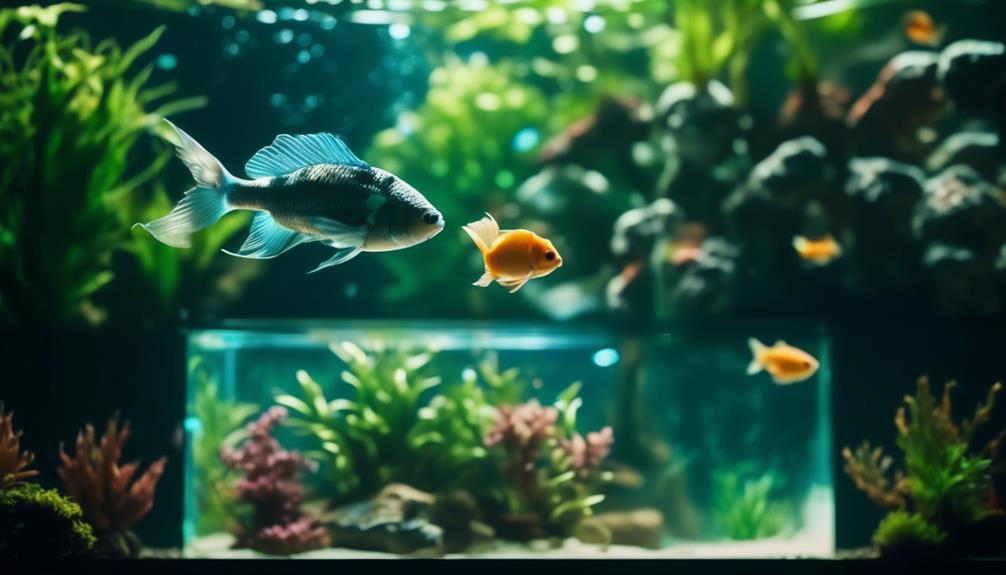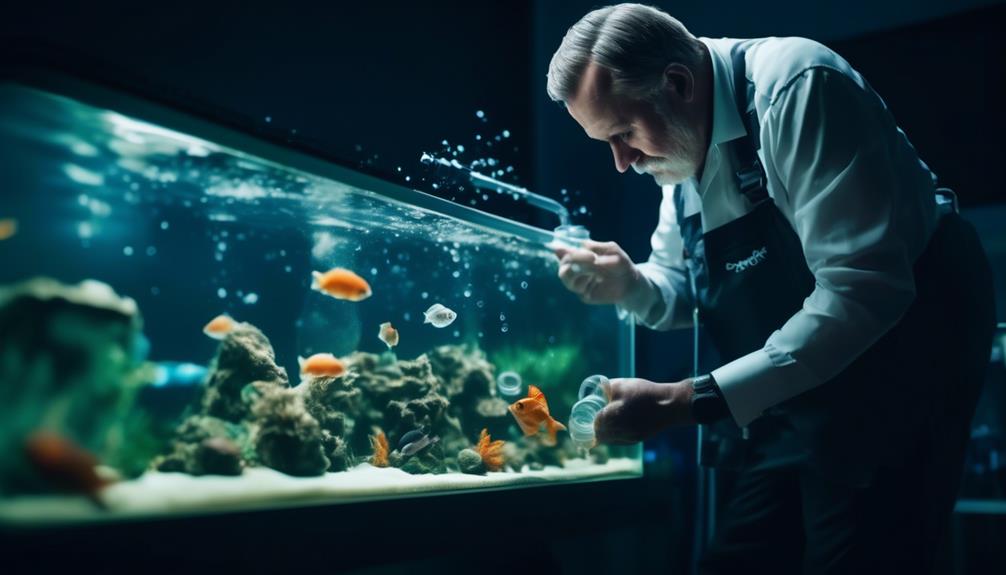Aquarium owners have long understood the importance of maintaining optimal water quality for the health and well-being of their aquatic pets.
However, a lesser-known secret lies in the use of water dechlorinators, which play a crucial role in ensuring the safety of the aquatic environment.
In this article, we will uncover the secrets behind water dechlorinators, shedding light on their functions, significance, and the vital safety considerations that every aquarium owner should be aware of.
By delving into the world of water dechlorinators, we will not only unravel the mysteries surrounding these essential products, but also equip aquarium owners with the knowledge they need to make informed decisions for their beloved aquatic companions.
Key Takeaways
- Water dechlorinator is essential for removing chlorine and chloramine from tap water, which can be toxic to aquatic animals and beneficial bacteria.
- Proper dosage of water dechlorinator is important to ensure the safety of fish and other aquatic animals. Dosage instructions may vary depending on the dechlorinator used and the chlorine concentration in tap water.
- It is recommended to test tap water for chlorine levels and experiment with different levels to determine the optimal dosage of dechlorinator.
- Water dechlorinator works by chemically binding to chlorine and chloramine, converting them into non-toxic substances and detoxifying ammonia. It does not leave any harmful residue in the water.
Importance of Water Dechlorinator
The use of a water dechlorinator is crucial for maintaining the health and well-being of aquatic animals in both municipal and well water supplies. Municipal water supplies often disinfect water using chemicals such as chlorine or chloramine. While effective in killing harmful bacteria, these chemicals can be toxic to aquatic life. Chlorine, in particular, can cause significant damage to fish gills and other sensitive tissues.
By using a water dechlorinator, the chlorine and chloramine are effectively removed from the tap water, ensuring that it is safe for aquatic animals. This not only prevents harm to the animals but also promotes their overall health and longevity.
Safety and Dosage Considerations
To ensure the safe and effective use of water dechlorinator, it is important to consider various factors. These factors include tank size, water volume, and the sensitivity of fish species to chlorine.
When using water dechlorinator, it is crucial to follow proper usage guidelines to avoid potential dangers. Dosage instructions may vary depending on the specific dechlorinator being used.
General guidelines suggest using 1 ml of dechlorinator per 10 gallons of water. However, testing tap water for chlorine levels can help determine the appropriate dosage.
It is also recommended to dose the dechlorinator in a separate container before adding it to the aquarium. This helps ensure that the dechlorinator is evenly distributed throughout the water.
Additionally, maintaining a well-oxygenated tank through increased surface agitation can prevent oxygen depletion. This further enhances the safety of using water dechlorinator.
Recommended Water Dechlorinator

A highly recommended water dechlorinator for aquarium use is Fritz Complete Water Conditioner. This brand is known for its effectiveness in removing chlorine and chloramine from tap water, making it safe for aquatic animals.
Fritz Complete Water Conditioner is one of the best dechlorinator brands available in the market. Using a water dechlorinator like Fritz Complete offers several benefits, such as preventing gill burns in fish and protecting beneficial bacteria. It also neutralizes ammonia and detoxifies harmful compounds, leaving no residue or by-products in the water.
The easy-to-use pump head of Fritz Complete Water Conditioner makes it convenient for aquarium owners to dose the appropriate amount of dechlorinator.
How Water Dechlorinator Works
Water dechlorinators work by neutralizing and converting chlorine and chloramine into non-toxic substances, effectively removing these harmful compounds from tap water used in aquariums. They accomplish this through the following mechanisms:
- Chemical Binding: Dechlorinators chemically bind with chlorine and chloramine, rendering them harmless.
- Conversion to Non-Toxic Substances: These products break down chlorine molecules into chloride ions, which are safe for aquatic animals. They also detoxify ammonia released from chloramine.
- Residue-Free: Water dechlorinators leave no residue or harmful by-products in the water, ensuring the safety of the aquarium inhabitants.
When considering the pros and cons of using water dechlorinator, it is important to compare different brands. Factors to consider include their effectiveness in removing chlorine and chloramine, ease of use, presence of additional additives like pH buffers, and compatibility with different water conditions.
Factors and Tips for Using Dechlorinator

When using a dechlorinator for aquarium water, it is important to consider various factors and follow certain tips to ensure its effectiveness and the safety of the aquatic animals.
Factors that affect dechlorinator dosage include the chlorine and chloramine levels in tap water, tank size, sensitivity of fish species to chlorine, water temperature, pH levels, and desired level of chlorine removal.
It is recommended to treat tap water with dechlorinator before adding it to the aquarium and to use a water conditioner that also removes heavy metals and detoxifies ammonia.
Allowing the dechlorinator to mix with water for a few minutes before adding it to the tank is also advised.
Proper storage of dechlorinator in a cool, dark place is crucial to maintain its effectiveness.
Regularly testing tap water for chlorine and chloramine levels will ensure the proper dosage is used.
Frequently Asked Questions
Can Water Dechlorinator Be Used in Saltwater Aquariums?
Water dechlorinator is typically used in freshwater aquariums to remove chlorine and chloramine from tap water. However, it is not recommended for use in saltwater aquariums. There are alternative methods for dechlorinating saltwater that should be used instead.
Is It Necessary to Use Water Dechlorinator for Water Changes in Established Aquariums?
Using a water dechlorinator in established freshwater aquariums has pros and cons. It removes chlorine, which is toxic to fish, but may also remove beneficial bacteria. Alternatives include using aged water or a carbon filter.
Can Water Dechlorinator Remove Other Harmful Chemicals Like Heavy Metals?
Water dechlorinators are primarily designed to remove chlorine and chloramine from tap water, which are harmful to aquatic animals. While some dechlorinators may also have the ability to remove heavy metals, their effectiveness on different types of fish tanks may vary.
How Long Does It Take for the Dechlorinator to Neutralize Chlorine and Chloramine?
The effectiveness of dechlorinator in neutralizing chlorine and chloramine can vary based on factors such as water temperature, pH levels, and desired level of removal. It typically takes a few minutes for the dechlorinator to fully neutralize these chemicals.
Can Water Dechlorinator Be Used in Conjunction With Other Aquarium Treatments, Such as Medications or Fertilizers?
Using multiple treatments in aquariums may pose potential risks when combined with water dechlorinator. It is important to carefully read product labels and consult with a professional to ensure compatibility and avoid any negative interactions.
Conclusion
In conclusion, water dechlorinators play a vital role in maintaining optimal water quality in aquariums. By removing harmful chemicals like chlorine and chloramine from tap water, these products ensure the safety and well-being of aquatic animals and beneficial bacteria.
It is important for aquarium owners to consider safety and dosage considerations when using water dechlorinators, and to select the right product for their specific needs. Understanding the working mechanism of dechlorinators and following recommended guidelines will help create a healthy and thriving aquatic ecosystem.
Just as a shield protects a knight, water dechlorinators safeguard the delicate balance of an aquarium.

